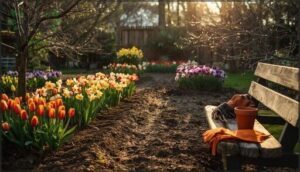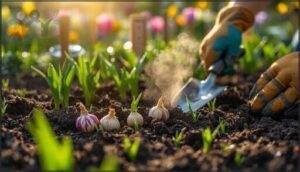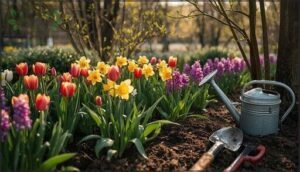This site is supported by our readers. We may earn a commission, at no cost to you, if you purchase through links.

If you want your spring flowers to thrive, every step counts, from picking the right blooms for your sunlight to planting bulbs deep enough to dodge a late frost.
These spring flower planting tips will help you sidestep common mistakes and set your garden up for a season of healthy, vibrant color.
Table Of Contents
- Key Takeaways
- Spring Flower Preparation
- Choosing Spring Flowers
- Planting Spring Flowers
- Caring for Spring Flowers
- Maintaining Garden Health
- Frequently Asked Questions (FAQs)
- When should you start planting your spring flowers?
- What not to do when planting flowers?
- How do I prepare my flower beds for spring?
- How to layout a flower garden for beginners?
- How do I get my Garden ready for spring?
- Can you plant a flower garden in spring?
- What flowers should I plant in a Spring Garden?
- How do I prepare my garden for the spring equinox?
- What is a Spring Gardening checklist?
- When should you plant flowers in a small garden?
- Conclusion
Key Takeaways
- Starting with a clean garden—removing weeds, debris, and old mulch—reduces pests and sets the stage for healthy plants.
- Matching your flower choices to your garden’s sunlight and climate helps ensure strong blooms and fewer headaches all season.
- Plant bulbs at the right depth and time, using soil temperature and local frost dates as your guide for the best results.
- Continuous care—regular watering, mulching, deadheading, and natural pest control—keeps your spring flowers vibrant and thriving.
Spring Flower Preparation
Getting your garden ready for spring means starting with a clean, healthy foundation. A few simple steps can make all the difference for your flowers. Here’s what you’ll want to tackle first.
Removing Weeds and Debris
When you step into your spring garden, think of weed and debris removal as setting the stage for everything that follows. Early weed removal, especially when the soil is damp, lets you pull roots cleanly, stopping regrowth in its tracks. Clearing away winter’s leftovers—dead leaves, broken stems, and old mulch—cuts down on pests and disease. Remember, selective debris thinning protects helpful insects, while overly aggressive cleanup can do more harm than good. The ideal time is when temperatures reach 50°F, guaranteeing best conditions.
- Remove weeds weekly for effective long-term suppression
- Strip decomposed mulch to avoid fungal problems
- Dispose of debris through local yard waste pickup for environmental benefits
Adding Compost and Organic Matter
Once weeds and debris are cleared, it’s time to enrich your beds. Spread two inches of compost across the soil—this boosts nutrient release and improves water retention.
Well-aged organic matter feeds microbial activity, strengthens soil structure, and keeps roots happy. Incorporating soil compost benefits plant growth.
Mix in kitchen scraps and yard clippings, but stick to fertilizing guidelines to avoid buildup. Healthy soil preparation sets every flower up for success.
Loosening Compacted Soil for Airflow
After enriching your soil with compost, focus on loosening compacted areas. Use Aeration Methods like broad forking to open up the ground to about six inches deep. This reduces Soil Density, boosts Root Respiration, and improves Water Infiltration for healthier flowers.
Well-aerated beds encourage Microbial Activity and better soil drainage. If you’re unsure about soil composition, soil testing helps guide further amendments—giving your spring garden the strong foundation it needs.
Choosing Spring Flowers
Picking the right spring flowers is where your garden’s personality starts to shine. You’ll want blooms that fit your space, your schedule, and your climate.
Here are a few options to help you choose what works best for your garden.
Low-Maintenance Blooms for Beginners
Ever wonder which flowers practically care for themselves? If you want a garden that’s easy to manage, start with these reliable choices. For beginners, low-maintenance blooms are a smart way to learn flower gardening without headaches. Consider these three:
- Marigolds and zinnias thrive in poor soil and forgive missed watering.
- Daffodils and crocuses offer years of color—most survive with minimal fuss.
- Coneflowers and black-eyed Susans boast drought tolerance, pest resistance, and long bloom duration.
These picks excel in basic soil requirements and don’t crowd your space. With smart flower selection, garden maintenance becomes a rewarding, stress-free experience.
Tropicals and Pollinator Favorites
Color draws pollinators like a magnet, and tropical flowers are your ticket to a lively garden. Royal Poinciana, Heliconia, and Plumeria excel at Nectar Production, supporting hummingbirds and bees all season.
For strong Pollinator Support, choose varieties adapted to your microclimate—warm, humid spots suit these best. Smart flower selection means weaving in Seasonal Blooms, ensuring continuous color.
Tropical Adaptation is key, so match plants to your space for thriving spring flower planting.
Delicate Blooms for a Charming Garden
A well-chosen mix of delicate spring-blooming flowers can turn your garden into a tapestry of color and texture. Choosing the right flowers means looking for high Bloom Diversity and reliable Frost Tolerance. Sweet alyssum thrives on steady Soil Moisture, while baby’s breath offers impressive Petal Count for airy bouquets. Forget-me-nots, with self-seeding habits, guarantee lasting charm. For a successful spring garden, weave these gentle blooms into your planting techniques for fragrance intensity and visual delight.
- Sweet alyssum’s gentle fragrance intensity
- Baby’s breath’s airy bloom diversity
- Forget-me-nots’ persistent spring charm
Selecting Flowers for Specific Sunlight Conditions
When choosing flower varieties, pay close attention to sunlight requirements. Full-sun varieties like marigolds and zinnias thrive with six or more hours of direct light. Partial-shade blooms—think primroses or pansies—prefer filtered sun. For deep-shade options, hellebores and Solomon’s Seal are reliable.
Understanding bulb sunlight needs and phototropism effects helps you match blooms to every garden bed’s sun exposure.
Planting Spring Flowers
Once you’ve picked out your spring flowers, it’s time to get them in the ground the right way. A few key steps will help your plants settle in and thrive. Here’s what you need to know before you start planting.
Planting at The Right Depth and Time
Did you know planting bulbs too shallow leaves them vulnerable to frost, while too deep can stunt their blooms? Getting spring flower planting right means following proven bulb depth ratios—two to three times the bulb’s height. For best seasonal blooms, watch soil temperature needs; aim for above 40°F after frost date timing. Climate zone adjustments matter, too.
Here’s your checklist:
- Confirm local frost dates.
- Measure planting depth carefully.
- Test soil temperature before planting time.
Choosing The Right Bulbs for Your Location
Ever noticed how some bulbs burst into bloom while others barely survive? That’s the magic—and challenge—of matching flower varieties to your Hardiness Zones, Sunlight Needs, and Soil Drainage.
Before planting flowers, check your USDA zone; tulips and daffodils flourish from zones 3–8, gladiolus in warmer spots. Pick bulbs that feel firm, avoid soft or moldy stock, and watch for local microclimates—sheltered corners or sunny slopes often boost seasonal blooms and help sensitive bulbs thrive.
Planting Considerations for Different Types of Bulbs
Think of bulb planting as a game of depth and timing—large tulips demand deep holes, while crocus bulbs thrive closer to the surface. Adjust bulb depth for your soil type; sandy soils need bulbs deeper, clay soils shallower.
Consider bulb lifecycles and chill duration, too. Bigger bulbs store more energy, producing stronger spring flower planting results year after year.
Watering and Mulching for Optimal Growth
Once your bulbs are settled at the right depth, focus shifts to watering frequency and mulching benefits. Deep watering just once a week encourages roots to reach down, building sturdy plants. Mulch types matter—organic mulches like wood chips or compost lock in soil moisture and boost soil retention, cutting water needs by two-thirds. Drip irrigation increases efficiency, delivering water straight to the roots and minimizing waste.
A two-inch mulch layer suppresses weeds and keeps soil cool. Finger-test soil moisture regularly, and you’ll notice fewer weeds, healthier roots, and blooms that last longer through spring’s unpredictable weather.
Caring for Spring Flowers
Once your spring flowers are in the ground, a little care goes a long way. There are a few key steps that help them stay healthy and full of color.
Here’s what you’ll want to focus on as the season unfolds.
Providing The Right Amount of Sunlight and Water
When planning your spring garden, pay close attention to sunlight duration and watering techniques. Most flowers thrive with 6–8 hours of sun, though partial shade suits drought-tolerant flowers and native varieties.
Check soil moisture often—water deeply when the top inch dries. Mulching helps balance moisture, while microclimate monitoring ensures pollinators and delicate blooms get the right conditions for healthy growth.
Ensuring Well-Draining Soil and Fertilization
Just as sunlight shapes growth, well-draining soil keeps roots healthy and strong. Test your soil pH and nutrient levels before adding fertilizers—timing matters for bloom quality. Mix in compost or organic fertilizers to boost fertility and structure. For best results, remember:
- Improve drainage in clay-heavy beds
- Apply fertilizers sparingly
- Watch for signs of nutrient deficiency
Deadheading Spent Blossoms for Continuous Blooms
Just as healthy roots depend on good soil, vibrant blooms rely on regular deadheading. When you deadhead spent blossoms, you’re giving your flowering plants a second wind—redirecting their energy from seed production to new blooms. For instance, weekly deadheading can boost bloom density by up to 60% in zinnias and marigolds. Use clean pruners or pinch faded flowers above a healthy leaf node.
Here’s how you keep your garden blooming strong:
- Remove faded blooms promptly
- Cut stems above new buds
- Inspect for plant health with each flower care session
Protecting Plants From Frost and Wind Damage
Even as spring warms the soil, late frosts and gusty winds can catch you off guard. Protecting plants from frost means using row covers or cold frames when frost dates linger. Windbreak effectiveness jumps with burlap screens, shielding blooms from harsh gusts. Mulch application insulates roots, while irrigation techniques and microclimate management—like planting near walls—buffer temperature fluctuations. Physical barriers and careful timing offer reliable frost protection, keeping your garden resilient despite unpredictable climate swings.
| Technique | Benefit | Best Use |
|---|---|---|
| Windbreaks | Reduces wind stress | North/west perimeters |
| Row Covers | Warms canopy | Below 35°F nights |
| Mulch Application | Insulates roots | Early spring frosts |
| Irrigation Techniques | Prevents blossom loss | Frost events |
| Microclimate Management | Buffers temperature | Near buildings/slopes |
Maintaining Garden Health
Once your flowers are planted, keeping your garden healthy is the next step.
There are a few key habits that make all the difference. Let’s look at some practical ways to keep your plants thriving this spring.
Controlling Pests and Diseases Naturally
Ever wondered how your garden can defend itself without chemical sprays? Beneficial insects like ladybugs and nematodes handle pest control, while companion planting with marigolds or basil boosts disease resistance.
Neem oil and other organic pesticides disrupt pests but spare pollinators. Mixing natural repellents and integrated pest management lets you weave cultural controls into your routine, keeping disease and pest management steady and your spring flowers thriving.
Pruning and Training Plants for Maximum Growth
With a sharp pair of shears and a steady hand, you can shape your spring garden’s future. Pruning techniques—like cutting just above leaf nodes or thinning crowded stems—boost bloom density and trigger hormonal effects that encourage new growth.
Seasonal pruning of trees and shrubs keeps structural integrity strong, while pinching young shoots creates bushier, more vigorous plants.
By weaving these gardening techniques into your routine, you’ll promote lasting health and elevate every flower’s potential.
Adding Support Structures for Certain Perennials
Did you know installing plant stakes early can boost perennial stem strength by 20%? Timing is key—stake when shoots reach 10–15 cm, so roots stay undisturbed and plants stand tall all season.
Metal cages and trellises last for years, while bamboo is lighter but breaks down faster, making Material Durability a real consideration.
Plant structures—hoops, grids, and rings—do more than prevent flopping; they improve airflow, reduce fungal issues, and keep flower beds looking sharp.
- Early Plant Stake Installation Timing
- Durable cages and trellises for perennials
- Functional Benefits: better airflow, fewer diseases
- Design Trends: modular panels for small spaces
- Sustainability Impact: recycled, eco-friendly materials
Modular trellis panels are trending in compact gardens, and sustainable options like recycled metal or bamboo cut your Sustainability Impact.
Monitoring and Adjusting Garden Conditions for Optimal Health
Why let your garden’s health slip through the cracks when a little attention goes a long way? Check soil moisture weekly—dry an inch down means it’s time to water. Keep an eye out for yellow leaves or spots, signaling pest or disease control needs.
Monthly soil tests help you adjust nutrient balance, light exposure, and microclimate control for thriving spring flowers.
Frequently Asked Questions (FAQs)
When should you start planting your spring flowers?
You’ll want to start spring planting once soil temperatures reach at least 60°F and your local frost date has passed.
In colder hardiness zones, wait two weeks after the last frost for tender varieties—check microclimates and forecasts.
What not to do when planting flowers?
Picture planting seeds in a puddle—roots drown, growth stalls, and blooms never appear. Avoid overwatering, spacing issues, deep planting, soil compaction, and ignoring pH.
Start with solid soil preparation and garden maintenance for healthier flowers.
How do I prepare my flower beds for spring?
Start by clearing away leaves and lingering mulch from your flower beds. Aerate compacted soil, pull weeds early, and mix in compost.
Test soil pH, adjust as needed for balance, then add fresh mulch for organic enrichment.
How to layout a flower garden for beginners?
Sketch your garden layout with clear boundaries, then group taller plants at the back and shorter varieties up front.
Combine bold color schemes and create focal points for interest, always matching flower bed size with easy garden maintenance.
How do I get my Garden ready for spring?
Begin spring gardening by clearing away winter debris, testing soil pH, and dividing perennials.
Focus on soil preparation—add compost and loosen compacted areas. Prune damaged branches and apply mulch for moisture retention.
Plan planting times to ensure a vibrant, healthy garden.
Can you plant a flower garden in spring?
Just as every garden tells its own story, spring is the prime chapter for planting flowers.
Spring is when your garden’s story comes alive—the perfect moment to plant new beginnings
With careful garden planning and attention to soil temperature and frost risks, spring planting success depends on choosing varieties suited to your region’s bloom timeframes.
What flowers should I plant in a Spring Garden?
Choose pansies, primroses, and snapdragons for vivid early blooms. Add daffodils, tulips, and crocuses for classic spring color.
Match flower height and soil type to your garden, and favor regional favorites for reliable spring gardening success.
How do I prepare my garden for the spring equinox?
For Equinox Garden Prep, start with spring soil testing to check pH and nutrients. Clear debris sparingly—minimal removal aids soil life. Add compost for early soil amendment timing, prune winter damage, and plan your layout for efficient spring flower planting.
What is a Spring Gardening checklist?
Spring’s secret is in smart starts—sweep away debris, test soil pH, prune, divide perennials, plant cool crops, start seeds indoors, mulch, prep tools, inspect irrigation, and sketch your spring garden checklist for region and budget planning.
When should you plant flowers in a small garden?
The best time for planting flowers in a small garden depends on your hardiness zone, local microclimate, and last frost date impact.
Wait for consistent soil temperatures above 60°F for most spring flowers—early planting risks frost damage and weak growth.
Conclusion
Funny how spring flower planting tips often sound like a strict rulebook—a garden will always call your bluff. Skip a single step, and nature writes the punchline: weeds throw parties and bulbs sulk in silence.
But when you take the time for care and attention, you invite a different kind of surprise—blooms so vivid, neighbors slow down to look. That’s the quiet trick of a well-tended spring garden: it repays diligence with joy, not just color.
- https://www.umass.edu/agriculture-food-environment/home-lawn-garden/fact-sheets/when-can-i-plant-flowering-plants-in-spring
- https://www.1800flowers.com/articles/flower-facts/spring-planting-guide
- https://www.climate.gov/news-features/event-tracker/first-blooms-2025-spring-season-were-earlier-average-across-most-united
- https://www.epa.gov/climate-indicators/climate-change-indicators-leaf-and-bloom-dates
- https://dug.org/gardening-resources/soil-prep/









